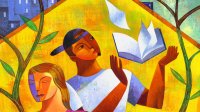4 Ways to Use Mentor Texts During the Pandemic
Students can connect with topics that ring true to their lives while practicing techniques modeled by professional writers.
Your content has been saved!
Go to My Saved Content.As I watch another dire day recounted on the nightly news, I wonder how to extract meaning from this experience. While the subject of the pandemic can provide useful lessons in science, math, or history, it can also be used to teach students of all ages how to respond to crisis.
In the high school language arts curriculum, mentor texts are powerful tools for those times when original words evade us. The written word seeks to make sense of human experience—to bring into symmetry the plummets and peaks of lived reality—across time. Using poems and prose as entry points for discussion, reading, and writing amid uncertainty can frame and foster a sense of unity and connectedness.
Explore Mood and Emotions
In the poem “Lockdown,” Richard Hendrick names the emotions of the COVID-19 pandemic while simultaneously highlighting the ways in which human stillness has shifted the natural world. He highlights possibility and hope by reminding readers of humanity’s potential to better the world, even in a time of destruction. Students can explore the mood or tone of Hendrick’s piece. What decisions did he make as a writer to craft this tone? For example, anaphora in the opening “Yes” lines creates a sense of urgency. At the same time, Hendrick’s rich visual imagery offers a sense of hope that contrasts and complements the opening mood of emergency.
Tap into the emotional elements of text by asking what about a particular piece of writing—pacing, tone, or style—conjures specific thoughts and feelings in students. Ask them to make a list of the techniques they notice in mentor texts and discuss how these tools foster specific feelings.
By breaking texts down to the technical level, students can build their own toolboxes for writing, deepening understandings of literary devices while understanding how those devices drive a reader’s emotional and intellectual response to a text.
Relate to Their Own Experiences
Mentor texts can be useful as models of writing. Ask students to rewrite mentor texts in their own words. For example, students could write the first stanza of their own poem modeled after “Lockdown.” How might they use repetition, like Hendrick, or create short but evocative scenes, like the birds in Wuhan, that readers can see in their minds?
In Pablo Neruda’s “Keeping Quiet,” he advises that the reader “count to twelve” in a moment of stillness. Ask students to do the same and to notice what they see, smell, hear, taste, or think of during this time. After they construct a list of bullet points, students can write a poem using either their own experience, based on the list collected from the meditative moment, or the metaphorical “count of twelve”—the global stillness of the pandemic. Encourage students to explore what global stillness teaches them about opportunities for connection or change.
Find Humor and Hope
In “A Letter to My Students as We Face the Pandemic,” writer and teacher George Saunders shares with his students a delightful mix of humor, hope, and a recognition of the difficulties of the moment. He addresses young people directly, urging them to document their experiences for future generations, empowering them to take their perspectives seriously. Combining humor with poignancy, Saunders shares his perspective on the unique global situation.
Students might consider why Saunders’s letter is so effective. Examine how Saunders fosters feelings—and even laughter—without feeling inappropriate in the face of adversity. Consider asking students to practice writing with humor, even about a serious topic. The exercise can also allow students to explore how to balance serious subjects with levity and wit.
Ross Gay’s daily meditations on delight are documented in his wonderfully observant Book of Delights. He explores a range of subjects including systemic racism, human tenderness, and the color of a garden in spring. In a book about delight, Gay also engages many serious topics that are in no way delightful. When students study how he conjures a sense of hope and delight while still recognizing darkness, they can develop a better understanding of how writing can straddle both worlds, much in the way that Hendrick’s “Lockdown” melds seriousness with optimism. Ask students to look closely at the sentence structure and word choice that makes Gay’s work feel conversational.
Document the Present
Another way in which mentor texts may be used to teach during the pandemic is as a model for documentation. In the same way that Saunders crafted a letter to students, they can draft a letter to a young person living 50 years from now. What will they want the next generation to know? Students will decipher what they believe matters about this time and how they might share that with others, perhaps even with humor.
Using Hendrick’s “Lockdown,” invite students to capture and record observations from their daily life and translate them into verse, using sensory descriptions to convey sight, smell, sound.
With the Book of Delights as a model, students can keep their own daily delight journals. Ask them to document one thing per day that delights them. Then, in the style of Gay, ask students to create their own prose poem exploring selected “delights” in context. Journaling about the current situation is not only a creative writing exercise but also a way for students to explore how history is documented.
